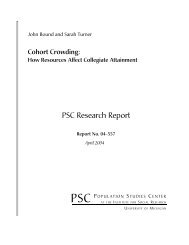Population Ageing and the Well-Being of Older Persons in Thailand ...
Population Ageing and the Well-Being of Older Persons in Thailand ...
Population Ageing and the Well-Being of Older Persons in Thailand ...
You also want an ePaper? Increase the reach of your titles
YUMPU automatically turns print PDFs into web optimized ePapers that Google loves.
Section 3: Demographic, Social <strong>and</strong> Economic Pr<strong>of</strong>ile<br />
To assess <strong>the</strong> material well-be<strong>in</strong>g <strong>of</strong> older persons we<br />
exam<strong>in</strong>e <strong>in</strong>come, <strong>the</strong> value <strong>of</strong> major assets, <strong>in</strong>dications<br />
<strong>of</strong> <strong>the</strong> quality <strong>of</strong> hous<strong>in</strong>g, <strong>and</strong> <strong>the</strong> presence <strong>of</strong> various<br />
household possessions. Each <strong>of</strong> <strong>the</strong>se dimensions has<br />
limitations that require care when <strong>in</strong>terpret<strong>in</strong>g results.<br />
This is especially so <strong>in</strong> <strong>the</strong> case <strong>of</strong> older persons who<br />
<strong>of</strong>ten live <strong>in</strong> households shared with younger<br />
members who may be <strong>the</strong> ma<strong>in</strong> source <strong>of</strong> household<br />
support. Under such circumstances <strong>the</strong> direct <strong>in</strong>come<br />
<strong>of</strong> <strong>the</strong> elderly members may be less important for <strong>the</strong>ir<br />
material well-be<strong>in</strong>g than <strong>the</strong> <strong>in</strong>come <strong>of</strong> o<strong>the</strong>r<br />
members <strong>of</strong> <strong>the</strong> household. Also <strong>in</strong> cases where older<br />
persons coreside, specific possessions <strong>of</strong>ten belong to<br />
<strong>the</strong> o<strong>the</strong>r members or to <strong>the</strong> household overall ra<strong>the</strong>r<br />
than to <strong>the</strong> elderly <strong>the</strong>mselves. Never<strong>the</strong>less, <strong>the</strong><br />
possessions at least reflect <strong>the</strong> overall wealth status <strong>of</strong><br />
<strong>the</strong> household <strong>and</strong> <strong>in</strong> many cases <strong>the</strong> older person<br />
typically benefit from <strong>the</strong>m. Additional issues arise<br />
when <strong>in</strong>terpret<strong>in</strong>g gender differences <strong>in</strong> <strong>the</strong> personal<br />
<strong>in</strong>come for married elderly s<strong>in</strong>ce spouses are likely to<br />
share <strong>in</strong>comes with each o<strong>the</strong>r. Likewise with<br />
ownership <strong>of</strong> assets, both partners <strong>in</strong> a married couple<br />
may benefit from <strong>the</strong> asset regardless <strong>of</strong> which spouse<br />
owns it. These caveats need to be considered when<br />
<strong>in</strong>terpret<strong>in</strong>g <strong>the</strong> results concern<strong>in</strong>g <strong>in</strong>come, assets,<br />
household wealth <strong>and</strong> household possessions presented<br />
below.<br />
Income <strong>and</strong> assets. Table 3.6 presents measures <strong>of</strong><br />
<strong>in</strong>come <strong>and</strong> wealth <strong>of</strong> persons age 60 <strong>and</strong> above by<br />
area <strong>of</strong> residence <strong>and</strong> gender. The upper panel<br />
<strong>in</strong>dicates <strong>the</strong> per cent distribution <strong>of</strong> <strong>the</strong> reported<br />
average annual <strong>in</strong>come <strong>in</strong> Thai baht (approximately<br />
33 Baht = US $1 at <strong>the</strong> time <strong>of</strong> <strong>the</strong> survey). Clearly<br />
older age urban residents have a more favorable<br />
<strong>in</strong>come distribution than <strong>the</strong>ir rural counterparts with<br />
<strong>the</strong> urban distribution far more concentrated towards<br />
higher levels <strong>of</strong> <strong>in</strong>come than rural distribution. While<br />
almost a fifth <strong>of</strong> rural residents reported under 10,000<br />
baht as <strong>the</strong>ir annual <strong>in</strong>come this was <strong>the</strong> case for only<br />
just over 10 per cent <strong>of</strong> urban residents. In contrast,<br />
almost half <strong>of</strong> urban residents reported <strong>in</strong>comes <strong>of</strong><br />
50,000 baht or more compared to less than a fourth<br />
<strong>of</strong> rural residents. The relative difference is even more<br />
strik<strong>in</strong>g for <strong>the</strong> share whose <strong>in</strong>come is 100,000 baht<br />
or more, a group that accounts for only 10 per cent <strong>of</strong><br />
rural residents but almost 3 times this share for urban<br />
residents.<br />
The lower panel shows <strong>the</strong> per cent distribution <strong>of</strong><br />
older persons with respect to <strong>the</strong> total value <strong>of</strong> <strong>the</strong>ir<br />
property <strong>and</strong> sav<strong>in</strong>gs. Property was def<strong>in</strong>ed broadly<br />
to <strong>in</strong>clude gold, expensive possessions such as a car,<br />
house, or l<strong>and</strong>. This measure <strong>of</strong> wealth shows a more<br />
complicated relationship with area <strong>of</strong> residence.<br />
Urban elderly are both somewhat more likely than<br />
<strong>the</strong>ir rural counterparts to have no such assets but also<br />
more likely to report hav<strong>in</strong>g property <strong>and</strong> sav<strong>in</strong>gs <strong>in</strong><br />
<strong>the</strong> highest category shown, i.e. those valued at one<br />
million or more. This likely reflects <strong>the</strong> greater<br />
availability <strong>of</strong> l<strong>and</strong> <strong>in</strong> rural areas <strong>and</strong> thus more<br />
widespread l<strong>and</strong> <strong>and</strong> home ownership among elderly<br />
rural than urban residents. 7<br />
As noted above, <strong>in</strong>terpret<strong>in</strong>g gender differences <strong>in</strong><br />
<strong>in</strong>come among married persons is complicated s<strong>in</strong>ce<br />
spouses likely share benefits from each o<strong>the</strong>r’s <strong>in</strong>comes.<br />
While access to <strong>in</strong>come does not necessarily imply<br />
decision mak<strong>in</strong>g <strong>and</strong> control over resources, <strong>in</strong><br />
Thail<strong>and</strong> with<strong>in</strong> <strong>the</strong> family wives have considerable<br />
power <strong>and</strong> typically control <strong>the</strong> household f<strong>in</strong>ances. 8<br />
Among <strong>the</strong> unmarried, however, gender comparisons<br />
are far less ambiguous s<strong>in</strong>ce <strong>the</strong>re is no spouse who<br />
may be shar<strong>in</strong>g <strong>in</strong>come with <strong>the</strong> respondent. For this<br />
reason we show gender differences not only for all<br />
elderly men <strong>and</strong> women but also separately for those<br />
who are not currently married. Overall, older men<br />
have a more favorable distribution <strong>of</strong> <strong>in</strong>come than do<br />
women, with more women than men concentrated<br />
<strong>in</strong> <strong>the</strong> lower <strong>in</strong>come categories <strong>and</strong> more men than<br />
women concentrated <strong>in</strong> <strong>the</strong> higher <strong>in</strong>come categories.<br />
When <strong>the</strong> <strong>in</strong>come distribution <strong>of</strong> unmarried men <strong>and</strong><br />
women are compared, however, <strong>the</strong>re is far less<br />
difference <strong>and</strong> men are actually more likely to fall <strong>in</strong>to<br />
<strong>the</strong> lowest <strong>in</strong>come category than are women. Thus<br />
<strong>the</strong> overall gender difference holds primarily for<br />
currently married persons among whom most are<br />
likely to be shar<strong>in</strong>g <strong>the</strong> benefits <strong>of</strong> <strong>the</strong>ir spouse’s<br />
24















